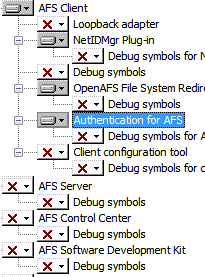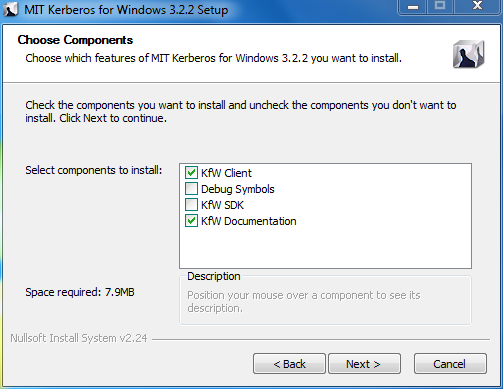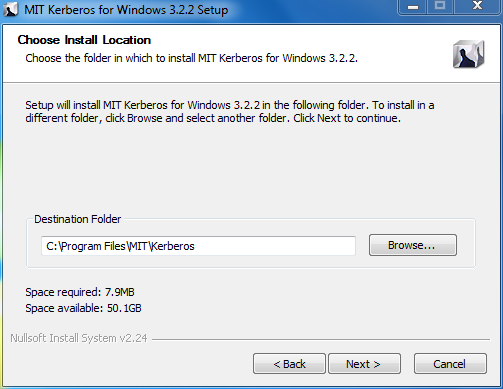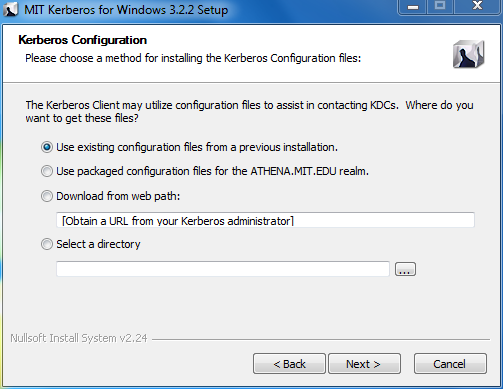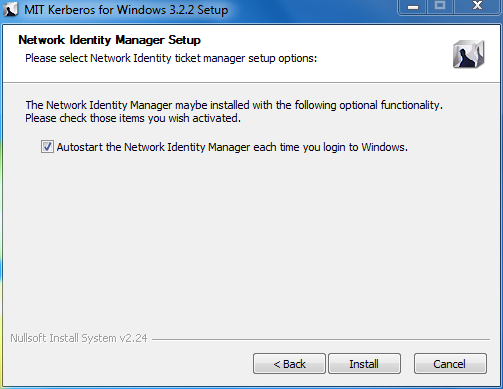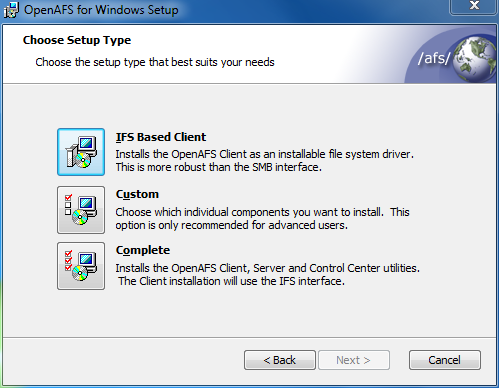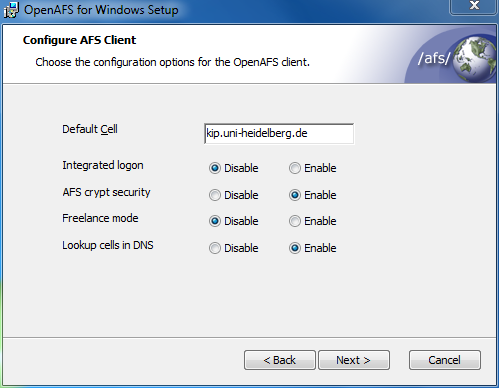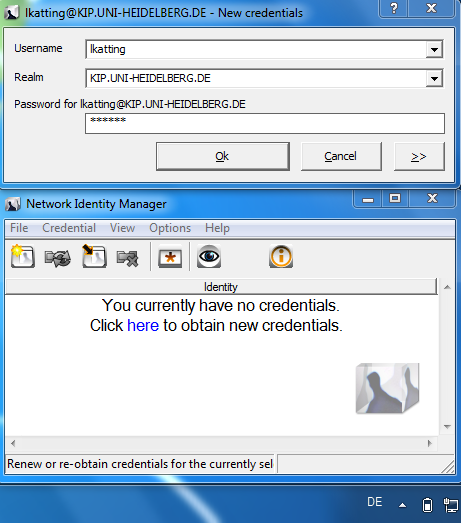EDV:OpenAFS/Windows: Difference between revisions
No edit summary |
|||
| Line 3: | Line 3: | ||
==== Upgrade auf Version 1.7.XX: ==== |
==== Upgrade auf Version 1.7.XX: ==== |
||
Beim Upgrade von Version kleiner / gleich 1.6.xx - den alten Client deinstallieren! |
Beim Upgrade von Version kleiner / gleich 1.6.xx - bitte den alten Client deinstallieren! |
||
Ab Version 1.7.X arbeitet der AFS Client für Windows mit einem nativen Filesystem Treiber und nicht mehr wie bisher über die Funktion SMB/Loopbackadapter. |
Ab Version 1.7.X arbeitet der AFS Client für Windows mit einem nativen Filesystem Treiber und nicht mehr wie bisher über die Funktion SMB/Loopbackadapter. |
||
Deshalb ist es notwendig bei einem Upgrade des Clients auf Version 1.7.XX, und zwar nach der Deinstallation des Clients, den |
Deshalb ist es notwendig bei einem Upgrade des Clients auf Version 1.7.XX, und zwar nach der Deinstallation des Clients, den |
||
[http://www-01.ibm.com/support/docview.wss?uid=swg21240069 Loopbackadapter zu entfernen]. |
[http://www-01.ibm.com/support/docview.wss?uid=swg21240069 Loopbackadapter zu entfernen]. |
||
Dies funktioniert am Besten über: |
Dies funktioniert am Besten über: |
||
Eigenschaften des Loopbackadapters > Karteikarte Treiber > Deinstallieren/Entfernen |
|||
Dieses Fenster findet man entweder im Gerätemanager oder unter Eigenschaften von Netzwerk. |
Dieses Fenster findet man entweder im Gerätemanager, oder unter Eigenschaften von Netzwerk. |
||
==== Installation des AFS Authentication Gui Tool, Installation ohne Kerberos/Heimdal: ==== |
==== Installation des AFS Authentication Gui Tool, Installation ohne Kerberos/Heimdal: ==== |
||
Damit man auch ohne Kerberos oder Heimdal einen Token erzeugen kann, gibt es immer noch die Möglichkeit das AFS Authentication Tool zu installieren. |
Damit man auch ohne Kerberos oder Heimdal einen Token erzeugen kann, gibt es immer noch die Möglichkeit das ''AFS Authentication Tool'' zu installieren. |
||
Hierfür ist es notwendig die Installation manuell/custom durchzuführen und die Auswahl der einzelnen Programmteile wie folgt zu treffen: |
Hierfür ist es notwendig die Installation manuell/custom durchzuführen, und die Auswahl der einzelnen Programmteile wie folgt zu treffen: |
||
<p style=margin-left:7%>[[image:afs_options.png| AFS Options]]</p> |
<p style=margin-left:7%>[[image:afs_options.png| AFS Options]]</p> |
||
| Line 33: | Line 34: | ||
Remove also the Loopback Adapter if present in the Device Manager. |
Remove also the Loopback Adapter if present in the Device Manager. |
||
On Windows7 you |
On Windows7 you need to run this script with Administrator privileges: right click on the file and select "Run as administrator"}} |
||
[http://www-01.ibm.com/support/docview.wss?uid=swg21240069 Uninstalling the Microsoft Windows Loopback Adapter] |
[http://www-01.ibm.com/support/docview.wss?uid=swg21240069 Uninstalling the Microsoft Windows Loopback Adapter] |
||
| Line 42: | Line 43: | ||
==== Download for 32-bit Windows ==== |
==== Download for 32-bit Windows ==== |
||
* [http://dl.openafs.org/dl/openafs/1.7.11/winxp/openafs-en_US-1-7- |
* [http://dl.openafs.org/dl/openafs/1.7.11/winxp/openafs-en_US-1-7-2000.msi 32-bit MSI installer] |
||
==== Downloads for 64-bit Windows ==== |
==== Downloads for 64-bit Windows ==== |
||
| Line 48: | Line 49: | ||
Both installers must be installed on 64-bit systems |
Both installers must be installed on 64-bit systems |
||
* [http://dl.openafs.org/dl/openafs/1.7.11/winxp/openafs-en_US-64bit-1-7- |
* [http://dl.openafs.org/dl/openafs/1.7.11/winxp/openafs-en_US-64bit-1-7-2000.msi 64-bit MSI installer] |
||
* [http://dl.openafs.org/dl/openafs/1.7.11/winxp/openafs-32bit-tools-en_US-1-7- |
* [http://dl.openafs.org/dl/openafs/1.7.11/winxp/openafs-32bit-tools-en_US-1-7-2000.msi 32-bit tools MSI installer] |
||
=== Kerberos (MIT) === |
=== >> Kerberos (MIT) === |
||
KFW 3.2.2 includes Network Identity Manager 1.3.1 |
KFW 3.2.2 includes Network Identity Manager 1.3.1 |
||
| Line 69: | Line 70: | ||
* [http://www.secure-endpoints.com/binaries/mit-kfw-3-2-2/kfw-amd64-3-2-2.msi MIT Kerberos for Windows 64 Bit] |
* [http://www.secure-endpoints.com/binaries/mit-kfw-3-2-2/kfw-amd64-3-2-2.msi MIT Kerberos for Windows 64 Bit] |
||
=== Kerberos (Heimdal) === |
=== >> Kerberos (Heimdal) === |
||
For further information and latest releases see: [http://www.h5l.org Heimdal Kerberos 5] |
For further information and latest releases see: [http://www.h5l.org Heimdal Kerberos 5] |
||
| Line 82: | Line 83: | ||
For Heimdal Kerberos you need to install the Network Identity Manager |
For Heimdal Kerberos you need to install the Network Identity Manager |
||
=== Network Identity Manager === |
=== >> Network Identity Manager === |
||
Network Identity Manager version 2.0 will be its own distribution that upgrades the Network Identity Manager components installed by KFW (MIT-Kerberos). |
Network Identity Manager version 2.0 will be its own distribution that upgrades the Network Identity Manager components installed by KFW (MIT-Kerberos). |
||
| Line 105: | Line 106: | ||
<br style="clear:both;" /> |
<br style="clear:both;" /> |
||
[[Image:kip_afs_mit3.PNG|right]] |
[[Image:kip_afs_mit3.PNG|right]] |
||
If you select the |
If you select the option |
||
* Download from web path: |
* Download from web path: |
||
then the web path for the config file is: |
then the web path for the config file is: |
||
http://printer.kip.uni-heidelberg.de/afsconfig/krb5.conf |
<nowiki> http://printer.kip.uni-heidelberg.de/afsconfig/krb5.conf </nowiki> |
||
<br style="clear:both;" /> |
<br style="clear:both;" /> |
||
[[Image:kip_afs_mit4.PNG|right]] |
[[Image:kip_afs_mit4.PNG|right]] |
||
| Line 139: | Line 139: | ||
The folder can be any (accessible) path starting with '''\\afs''' |
The folder can be any (accessible) path starting with '''\\afs''' |
||
=== Examples === |
|||
('' the shortcut \\afs\kip is also possible'' ): |
|||
* for the top level view: '''\\afs\kip.uni-heidelberg.de''' |
* for the top level view: '''\\afs\kip.uni-heidelberg.de''' |
||
| Line 149: | Line 150: | ||
You can map multiple folders to different drive letters, in order to organize a quick and convenient file access. |
You can map multiple folders to different drive letters, in order to organize a quick and convenient file access. |
||
| ⚫ | |||
| ⚫ | |||
| ⚫ | |||
\\afs\kip\<your location> |
|||
| ⚫ | |||
<br style="clear:both;" /> |
<br style="clear:both;" /> |
||
Revision as of 15:10, 20 November 2012
Generelle Installationsanweisungen und Anmerkungen:
Upgrade auf Version 1.7.XX:
Beim Upgrade von Version kleiner / gleich 1.6.xx - bitte den alten Client deinstallieren!
Ab Version 1.7.X arbeitet der AFS Client für Windows mit einem nativen Filesystem Treiber und nicht mehr wie bisher über die Funktion SMB/Loopbackadapter. Deshalb ist es notwendig bei einem Upgrade des Clients auf Version 1.7.XX, und zwar nach der Deinstallation des Clients, den Loopbackadapter zu entfernen. Dies funktioniert am Besten über:
Eigenschaften des Loopbackadapters > Karteikarte Treiber > Deinstallieren/Entfernen
Dieses Fenster findet man entweder im Gerätemanager, oder unter Eigenschaften von Netzwerk.
Installation des AFS Authentication Gui Tool, Installation ohne Kerberos/Heimdal:
Damit man auch ohne Kerberos oder Heimdal einen Token erzeugen kann, gibt es immer noch die Möglichkeit das AFS Authentication Tool zu installieren. Hierfür ist es notwendig die Installation manuell/custom durchzuführen, und die Auswahl der einzelnen Programmteile wie folgt zu treffen:
Client-Software
OpenAFS for Windows depends on a third party Kerberos 5 implementation for network authentication.
There are two supported options: MIT Kerberos for Windows and Heimdal Kerberos. For Windows7 64 Bit use Heimdal Kerberos on all other Systems the MIT Kerberos works well.
To access the AFS-Server you need to download and install the appropriate OpenAFS and Kerberos Software (sometimes tricky),
or use this KIP-AFS_Windows Installation Script, which automatically download, install and configure all needed software for you (recommended).
| IMPORTANT: Use only for a fresh installation, or uninstall the old Client-Software completely first!
Remove also the Loopback Adapter if present in the Device Manager. On Windows7 you need to run this script with Administrator privileges: right click on the file and select "Run as administrator" |
Uninstalling the Microsoft Windows Loopback Adapter
OpenAFS
For the latest releases visit the Homepage OpenAFS for Windows
Download for 32-bit Windows
Downloads for 64-bit Windows
Both installers must be installed on 64-bit systems
>> Kerberos (MIT)
KFW 3.2.2 includes Network Identity Manager 1.3.1
For further information and latest releases see: MIT Kerberos for Windows (KFW)
Download for 32-bit Windows
Download for 64-bit Windows
On 64-bit Windows install both the 32-bit and 64-bit MSI packages
>> Kerberos (Heimdal)
For further information and latest releases see: Heimdal Kerberos 5
Download for 32-bit Windows
Download for 64-bit Windows
For Heimdal Kerberos you need to install the Network Identity Manager
>> Network Identity Manager
Network Identity Manager version 2.0 will be its own distribution that upgrades the Network Identity Manager components installed by KFW (MIT-Kerberos).
For further information and documentation see: Network Identity Manager Homepage
Download for 32-bit Windows
Download for 64-bit Windows
Installation
Example installation with MIT Kerberos for Windows
If you select the option
- Download from web path:
then the web path for the config file is:
http://printer.kip.uni-heidelberg.de/afsconfig/krb5.conf
Client-Connection
After installing the AFS-Software you need to:
If the authentication was successful, you are able to access your data by
- Click: Start > Computer > Map network drive (in the tool-bar)
- In the "Map Network Drive window" choose an available drive letter from the drop-down list and type the name of the folder to map.
The folder can be any (accessible) path starting with \\afs
Examples
( the shortcut \\afs\kip is also possible ):
- for the top level view: \\afs\kip.uni-heidelberg.de
- for your Home directory: \\afs\kip.uni-heidelberg.de\user\<USERNAME>
Click the "Reconnect at logon" checkbox if this network drive should be mapped permanently.
You can map multiple folders to different drive letters, in order to organize a quick and convenient file access.
It is also possible to access the data temporary (on the fly) without dedicated drive-mapping by typing
\\afs\kip\<your location>
in the explorer address bar.
